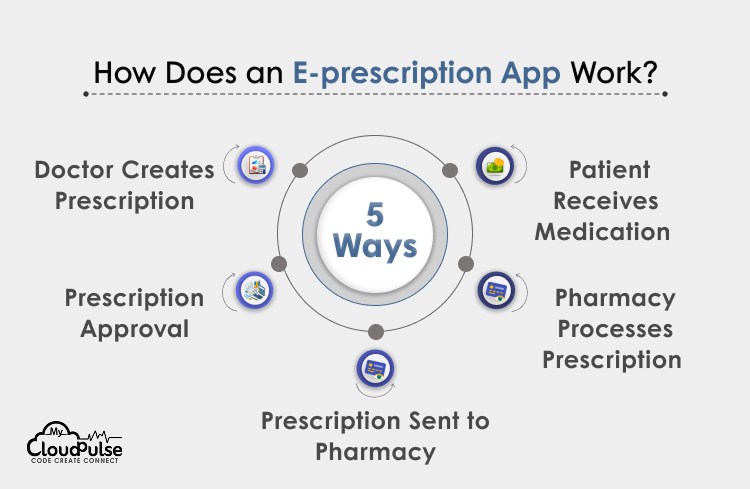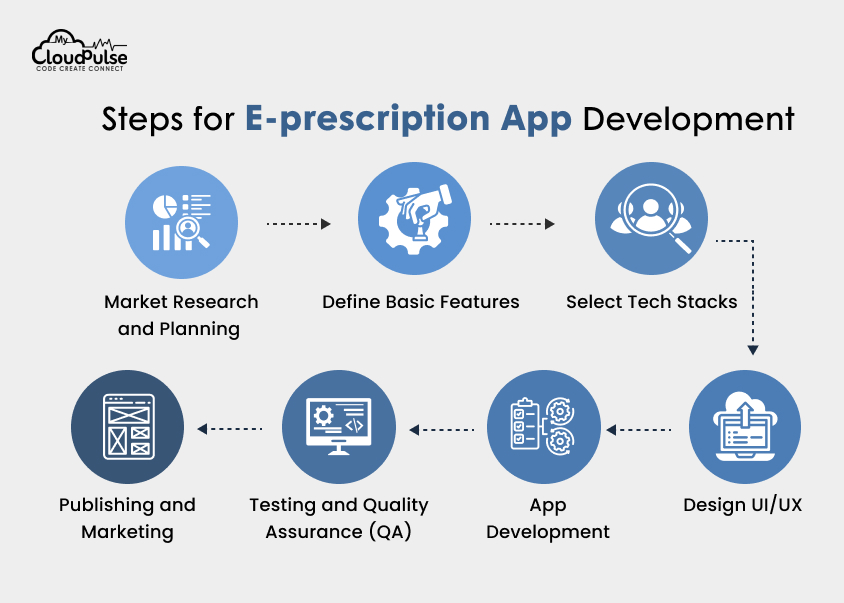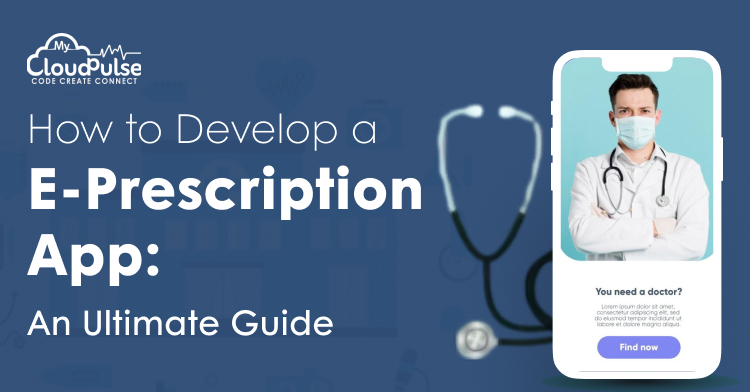“Connect, Prescribe, Care”
With our lives being busy more than ever, healthcare has taken a backseat. As a solution to the problem, the demand for efficient and accessible medical services is steadily increasing. Waiting in long lines, prescription errors, logistical challenges, busy lifestyle, etc. challenge the traditional healthcare solutions leading to the rise of e-prescription applications. These digital platforms empower healthcare providers to issue electronic prescriptions directly to patients and pharmacies, streamlining the medication process and enhancing patient care.
The global e-prescription market is projected to grow from $1380.50 million in 2023 to $4580.60 million by the year 2030 according to a study. It’s one grand revelation of how e-prescription app development has great potential for businesses willing to tap the health tech space.
This guide will highlight the most critical steps in the e-prescription app development process, emphasizing how this solution can allow businesses to make an expansionary leap into the market and facilitate better patient outcomes.
What is an E-prescription App?
An e-prescription app is a digital platform that allows healthcare providers (doctors, physicians, etc.) to easily transmit prescriptions to patients and pharmacies electronically. The digital prescriptions allow patients to access them securely within the app, enabling easy sharing of medical information with family members or other healthcare professionals as needed.
Because the app usually enables healthcare providers to create their digital profiles, patients can quickly schedule appointments and receive electronic prescriptions. As handwritten prescriptions are removed, e-prescription apps lower the risk of human error and offer patients increased flexibility in receiving their healthcare needs.
A reputable pharmacy app development services provider partners you to start the e-prescription form development. Such professionals bearing the great caliber will take you from A to Z to ensure a high-grade, budget-friendly, and user-centric mobile application.
How Does an E-prescription App Work?
The core functionality of the E-prescription app broadly includes streamlining the prescription process at both ends of the prescription spectrum, a job handed to the doctor and also a patient.

1. Doctor Creates Prescription
The doctor examines the patient’s condition and diagnoses a prescription. While on that, the allergies and contraindications to treatments that may jeopardize the safety of a patient have to be well considered.
2. Review by the Doctor
This is to ensure that the prescription that has been done is correct and appropriate. The prescription must be electronically signed by the doctor as an official document
3. Share Prescription with Pharmacy
The doctor should electronically send this signed prescription to the designated pharmacy. This practically eliminates the old-school addiction of giving paper prescriptions, which was found to be too time-consuming and a repetitive task, for the pharmacies to look after and the healthcare provider to consider.
4. Process Your Prescription
Depending on the information received; that is, the clinic generates the prescription and sends it to the pharmacy. The pharmacy looks at the e-prescription and checks if enough supplies exist for the prescribed medicines. After receiving confirmation, the medicine will be prepped and readied for dispensing.
5. Patient Receives Notification
The patient is notified that the medicine can be had for pickup or to be delivered to him. Also, GPS integration may allow patients to track their medications in real time once they leave the pharmacy. The patients may keep a secure payment gateway within the app for a quick and easy payment process.
The app also allows securely saved chats of both patients and healthcare providers filled with past prescription records, which become handy whenever needed.
Advanced Features of an E-prescription App
The modern e-prescription application is packed with an immense range of advanced features for better interaction and functionality:
a . Medication History
This provides doctors with a full overview of a patient’s medication history to enable informed decision-making and help them avoid drug interactions.
b. Allergy Checks
This allows doctors to do allergy checks beforehand so that they can avoid giving prescriptions that could trigger any adverse reaction in patients.
c. Telemedicine Integration
Telemedicine applications are easily integrated with e-Prescribing to provide a platform for remote consultations and issuance of e-Prescriptions to patients who cannot visit the clinic physically.
d. Prescription Tracking
Prescription status tracking enables patients to monitor their orders in real time for greater transparency and peace of mind, including their prescription processing, delivery, and pickup.
e. Automatic Prescription Refills
Continual reminders and automated requests for refills ease the whole prescription refilling a lot, enabling patients to always have the medication prescriptions they need.

f. Pharmacy Communication
E-prescription application features integrated communication between healthcare providers and pharmacies that allow prompt verification of medication availability and troubleshooting for any issues that may arise.
g. Multi-Language Support
The multi-language feature aims to make the app further accessible and inclusive to a wider audience.
h. Cloud Support
Data stored on a cloud makes it easy for healthcare providers to connect to patient records and prescription information from any site with an active Internet connection, conveniently and securely.
i. 24/7 Support
Full-time customer support staff are there for users to address any concerns or hiccups that may arise while using the app.
j. Notifications
Users are notified of new features, upgrades, and pertinent issues around medications and appointments that deserve their attention.
Steps for E-prescription App Development
Developing a successful e-prescription app requires a well-defined and methodical approach. Here are the key stages involved:

1. Market Research and Planning
Conduct thorough market research to analyze existing e-prescription apps, identify key trends, and understand the competitive landscape. Define your target audience, their specific needs, and the unique value proposition your app will offer.
2. Define Basic Features
Determine the core features and functionalities that are essential for your e-prescription app to achieve its objectives. Prioritize features that will deliver the most value to users and contribute to a seamless user experience.
3. Select Tech Stacks
Choose the most suitable technology stack for your app’s development. Consider factors such as scalability, performance, security, and ease of maintenance when making your selection.
4. Design UI/UX
Create a user-friendly and intuitive interface (UI) and user experience (UX) design. The design should be visually appealing, easy to navigate, and accessible to users of all technical abilities.
5. App Development:
The development phase involves translating the design and functionality into a fully functional mobile application. This stage requires a skilled development team to ensure the app’s stability, performance, and security.
6. Testing and Quality Assurance (QA)
Rigorous testing is crucial to identify and resolve any bugs, glitches, or performance issues before the app is released to the public.
7. Publishing and Marketing
Once testing and QA are complete, the app can be published on relevant app stores (e.g., Apple App Store, Google Play Store). A comprehensive marketing strategy is essential to raise awareness, attract users, and drive app downloads.
Why Entrepreneurs Must Invest in E-prescription App Development
Investing in e-prescription app development offers numerous benefits for businesses operating within the healthcare sector:
1. Reducing Errors
E-prescription apps significantly reduce the risk of human error associated with handwritten prescriptions, improving patient safety and minimizing the potential for medication errors.
2. Market Demand
The increasing demand for convenient and accessible healthcare solutions makes e-prescription apps a highly sought-after service among patients and healthcare providers alike.
3. Revenue Opportunities
E-prescription apps can generate revenue through various models, including subscription fees, in-app purchases, advertising, and transaction fees.
4. Operational Efficiency
By automating many aspects of the prescription process, e-prescription apps streamline workflows for both healthcare providers and pharmacies, enhancing operational efficiency and reducing administrative burdens.
5. Data Insights
E-prescription apps generate valuable data on user behavior, medication usage patterns, and healthcare trends. This data can be analyzed to identify areas for improvement, personalize services, and gain a deeper understanding of patient needs.
Significant Challenges to Develop an E-prescription App
While e-prescription apps offer multiple advantages, there are significant challenges to address during their development and execution process:

a. Integration with Healthcare Systems
Linking up the e-prescription apps with the other present healthcare units and electronic health records (EHR) could be quite a task and would require a lot of consideration and delicate management.
b. Data Security and Privacy
To protect the privacy of sensitive patient information, one of the most important and prioritized aspects of e-prescription development is to set up strong security features under entrusting processes like encryption and a two- or multi-factor authentication flow.
c. Pharmacy Readiness
Considerable effort is being put into making sure pharmacies are prepared for these e-prescriptions, including software upgrades, staff training, and robust infrastructure to turn them into electronic data exchange.
d. Development and Implementation Policing:
The building of this e-prescription app, as well as its implementation, is usually done at a very high cost, considering the time consumed in development and the other following costs of setting it for use: device maintenance, implementation with the pre-existing systems, and ongoing support..
e. Connectivity Issues
The e-prescription apps should be developed in a way that allows them to work perfectly without the encumbrance of network connectivity.
E-prescription App Development Cost
Factors in developing an e-prescription app decide how much it’ll cost to build one; some of them include:
- Complexity of the App: How complicated an app is determines how large the development work assigned to it is.
- Platform and Device Type: The heavy cost involved in developing two platforms (iOS and Android) instead of just targeting one.
- Development Team: Consider in this item the experience of the assigned development team, their job methods, and where around the globe they live compared to other regions.
- Design and UI/UX: The amount of elegance paid for design input and its relation to the overall quality of the user interface UX behind the app.
- Third-party Integrations: The cost expense any other expense that manifests in this light-is the integration cost, which emanates from linking things like pharmacies, EHR, and payment gateways.
Here’s a general cost estimate based on app complexity:
- Simple App Development: 2-5 months, $8,000 – $12,000
- Mid-Complexity App Development: 6-8 months, $13,000 – $20,000
- Complex App Development: 9+ months, $25,000+

Ongoing maintenance costs typically range from 15% to 20% of the initial development cost and include factors such as:
- User Support: Providing ongoing customer support to users and resolving any technical issues.
- Security Maintenance: Regularly updating security measures to protect user data and ensure compliance with relevant regulations.
- Software Updates: Implementing regular software updates to address bugs, improve performance, and add new features.
- Infrastructure Costs: Maintaining the necessary infrastructure, such as servers, databases, and cloud storage.
Why Choose CloudPulse to Develop an E-prescription App?
CloudPulse is a leading e-prescription app development company with over 14 years of experience in delivering innovative and high-quality mobile applications. Our team of skilled developers possesses in-depth expertise in healthcare technology and can provide comprehensive solutions tailored to your specific needs and requirements.
We prioritize user experience, security, and data privacy in all our projects. We offer a full range of services, from initial consultation and design to development, testing, deployment, and ongoing maintenance. Our commitment to client satisfaction and our proven track record of successful project delivery make us an ideal partner for your e-prescription app development journey.
Conclusion
E-prescription apps are revolutionizing the healthcare landscape by streamlining the prescription process, enhancing patient safety, and improving overall healthcare efficiency. By investing in developing a robust and user-friendly e-prescription app, businesses can capitalize on this growing market, improve patient outcomes, and establish a strong presence in the digital healthcare ecosystem.
Disclaimer: This information is provided for general knowledge and informational purposes only and does not constitute professional advice. The specific costs and development timelines may vary depending on individual project requirements and other factors.
Frequently Asked Questions about E-prescription Apps:
Convenience: Patients can easily access and share their prescriptions electronically, eliminating the need for paper copies.
Reduced Errors: E-prescriptions minimize the risk of errors caused by illegible handwriting or misinterpretations.
Improved Medication Adherence: Automated refills and reminders can help patients stay on track with their medication schedules.
Increased Access to Healthcare: Telemedicine integration allows patients to receive prescriptions remotely, improving access to care, especially in rural areas.
Enhanced Patient Safety: Allergy checks and drug interaction warnings within the app help ensure patient safety.
High-level security measures: Reputable e-prescription apps employ robust security protocols, including encryption, secure data storage, and multi-factor authentication, to protect patient data.
Compliance with regulations: These apps adhere to strict data privacy regulations like HIPAA (Health Insurance Portability and Accountability Act) to ensure patient confidentiality.
Development costs: These vary based on app complexity, features, and the chosen development team.
Integration costs: Integrating the app with existing electronic health records (EHRs) and pharmacy systems may incur additional costs.
Maintenance costs: Ongoing maintenance includes software updates, security enhancements, and user support.
Hardware and infrastructure costs: Depending on the implementation, costs may include devices, network infrastructure, and data storage solutions.
Evaluate features: Consider the specific features you need, such as medication history, allergy checks, telemedicine integration, and prescription tracking.
Assess user interface: Choose an app with a user-friendly interface that is easy for both you and your patients to navigate.
Consider integration capabilities: Ensure the app integrates seamlessly with your existing EHR and preferred pharmacies.
Read reviews and compare options: Research different e-prescription app providers and compare their features, pricing, and customer support.
Request a demo or trial: Many providers offer free trials or demos, allowing you to test the app and see how it fits your workflow.
Resistance to change: Some healthcare providers and pharmacies may be hesitant to adopt new technology.
Integration complexities: Integrating the app with existing systems can be technically challenging and time-consuming.
Data security concerns: Ensuring the security and privacy of patient data is crucial and requires ongoing vigilance.
Maintaining compliance: Staying up-to-date with evolving regulations and ensuring compliance with data privacy laws is essential.
Technical support: Reliable and responsive technical support is crucial for resolving any issues that may arise.


